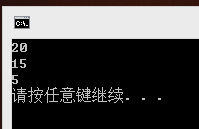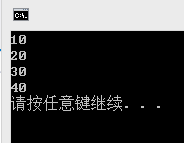二维数组,锯齿数组和集合 C# 一维数组、二维数组(矩形数组)、交错数组(锯齿数组)的使用 C# 数组、多维数组(矩形数组)、锯齿数组(交叉数组)
一.二维数组
二维数组:
一维数组----豆角
二维数组----表格
定义:
1.一维数组:
数据类型[] 数组变量名 = new 数据类型[数组长度];
数据类型[] 数组变量名 = new 数据类型[数组长度]{1,2,3....};
2.二维数组:
数据类型[,] 数组变量名 = new 数据类型[行数,列数];
int[,] a = new int[3,4];
赋值:
a[行下标,列下标] = 值 下标都是从0开始的
取值:
a[行下标,列下标]
题目:一个班6个人,从键盘输入每个学号语文,数学,外语成绩(不需输入学号)。输出:学生成绩表(包括每个人的总分),每科的平均分。
附加1:试着,把不及格的用红字显示。
附加2:试着按照总分排序,显示名次出来。
代码:

1 static void Main(string[] args)
2 {
3 //输入6个学生的语文,数学,英语成绩,输出总分和名次
4 int[,] a=new int[6,5];
5 //输入
6 for (int i = 0; i <6; i++)
7 {
8 Console.Write("请输入第{0}个学生的语文成绩:",i+1);
9 int yw = Convert.ToInt32(Console.ReadLine());
10 Console.Write("请输入第{0}个学生的数学成绩:", i+1);
11 int sx = Convert.ToInt32(Console.ReadLine());
12 Console.Write("请输入第{0}个学生的英语成绩:", i + 1);
13 int yy = Convert.ToInt32(Console.ReadLine());
14
15 a[i, 0] = i + 1;//学号
16 a[i, 1] = yw;
17 a[i, 2] = sx;
18 a[i, 3] = yy;
19 a[i, 4] = yw + sx + yy;
20
21 }
22
23 //排序
24 for (int i = 0; i <6; i++)
25 {
26 for (int j = i; j <5; j++)
27 {
28 if (a[i,4]<a[j+1,4])
29 {
30 int txh = a[j + 1, 0];
31 a[j + 1, 0] = a[i, 0];
32 a[i, 0] = txh;
33
34 int tyw = a[j + 1, 1];
35 a[j + 1, 1] = a[i, 1];
36 a[i, 1] = tyw;
37
38 int tsx = a[j + 1, 2];
39 a[j + 1, 2] = a[i, 2];
40 a[i, 2] = tsx;
41
42 int tyy = a[j + 1, 3];
43 a[j + 1, 3] = a[i, 3];
44 a[i, 3] = tyy;
45
46 int tzf = a[j + 1, 4];
47 a[j + 1, 4] = a[i, 4];
48 a[i, 4] = tzf;
49 }
50 }
51 }
52 Console.Clear();
53 //输出
54 Console.WriteLine("学号\t语文\t数学\t英语\t总分\t名次");
55 for (int i = 0; i < 6; i++)
56 {
57 Console.WriteLine("{0}\t{1}\t{2}\t{3}\t{4}\t{5}",a[i,0],a[i,1],a[i,2],a[i,3],a[i,4],i+1);
58 }
59 int sum1 = 0, sum2 = 0, sum3 = 0;
60 for (int i = 0; i < 6; i++)
61 {
62
63 sum1 += a[i, 1];
64
65 sum2 += a[i, 2];
66
67 sum3 += a[i, 3];
68
69
70 }
71 Console.WriteLine("平均分:{0}\t{1}\t{2}",sum1/6,sum2/6,sum3/6);
72
73 }

二.锯齿数据,数组的数组。
定义:
第一步:定义大数组
数据类型[][] a = new 数据类型[行数][];
第二步:定义小数组
数据类型[] a1 = new 数据类型[列数];
数据类型[] a2 = new 数据类型[列数];
......
第三步:把小数组放到大数组中
a[0] = a1;
a[1] = a2;
....
举例:

1 static void Main(string[] args)
2 {
3 //锯齿数组
4 int[][] a = new int[3][];
5 int[] a1 = new int[] {3,4,5,6,7};
6 int[] a2 = new int[] {1,2,3};
7 int[] a3 = new int[] {7,8,9,10};
8
9 a[0] = a1;
10 a[1] = a2;
11 a[2] = a3;
12
13 //显示
14 for (int i = 0; i <a.Length; i++)//a.length=3
15 {
16 for (int j = 0; j <a[i].Length; j++)
17 {
18 Console.Write(a[i][j]+"\t");
19 }
20 Console.Write("\n");
21 }
22
23 }

注意:
int[,] a = new int [3][4]; //错
int[][] a = new int[3,4]; //错
int[][] a = new int[3][4]; //错
int[,] c = new int[3,4]; //对,这是二维数组
c.length==12
三.集合:
一、ArrayList 链表,没有长度限制,可以随时向时添加或删除元素。
需要在前面加上:using System.Collections;
定义:
ArrayList a = new ArrayList();
操作:
a.Add(数据):添加
a.Insert(索引号,数据):插入
a.RemoveAt(索引号):删除
a.Count 集合中元素的个数
取值:
a[下标]
取出来的值需要进行强制转换。
举例:

1 static void Main000(string[] args)
2 {
3 ArrayList a = new ArrayList();
4 a.Add(10);
5 a.Add(20);
6 a.Add(25);
7
8 a.Insert(1, 15);
9
10 a.RemoveAt(2);
11
12 a[1] = (int)a[1] + 10;
13
14
15 for (int i = 0; i < a.Count; i++)
16 {
17 Console.WriteLine(a[i]);
18 }
19 }

运行结果:

二、List<类型> 链表,,没有长度限制,可以随时向时添加或删除元素。只能放指定类型的数据,取出来也不用强制转换。
定义
List<类型> 变量名 = new List<类型>();
List<int> a = new List<int>();
操作:
a.Add(数据):添加
a.Insert(索引号,数据):插入
a.RemoveAt(索引号):删除
a.Count 集合中元素的个数
a.Sort(); 排序
a.Reverse();反转
取值
a[索引号]
举例

1 static void Main(string[] args)
2 {
3 List<int> a = new List<int>();
4 a.Add(5);
5 a.Add(10);
6 a.Add(20);
7
8 a.Insert(2,15);
9 a.RemoveAt(1);
10
11 a.Sort();
12 a.Reverse();
13
14 for (int i = 0; i < a.Count; i++)
15 {
16 Console.WriteLine(a[i]);
17 }
18
19 }

运行结果:

三、Dictionary<key,value>字典或哈希表
定义
Dictionary<int,string> a = new Dictionary<int,string>();
操作:
a.Add(键值,数据);
a.Remove(键值);
a.Count;
取值:
a[键值]
举例:

1 static void Main(string[] args)
2 {
3 Dictionary<int, string> a = new Dictionary<int, string>();
4 a.Add(101,"haha");
5 a.Add(103,"hehe");
6 a.Add(105,"xixi");
7 a.Add(107,"哈哈");
8
9 a.Remove(103);
10 a[105] = "不许笑";
11 foreach (KeyValuePair<int,string>p in a)
12 {
13 Console.WriteLine(p.Value);
14 }
15 }

运行结果:

四、栈,队列 知道就行了
栈:先进后出,不能随机取其中任意一个值。
Stack<数据类型> a = new Stack<数据类型>();
a.Push(值);
数据类型 变量名 = a.Pop();
举例:

1 static void Main(string[] args)
2 {
3 Stack<int> a = new Stack<int>();
4
5 //向集合里推入元素
6 a.Push(10);
7 a.Push(20);
8 a.Push(30);
9 a.Push(40);
10 //将元素一个个弹出集合,因为stack 没有索引,所以遵循先进后出原则
11 Console.WriteLine(a.Pop());
12 Console.WriteLine(a.Pop());
13 Console.WriteLine(a.Pop());
14 Console.WriteLine(a.Pop());
15
16 }

运行结果:

队列:先进先出,不能随机取其中任意一个值。
Queue<int> a = new Queue<int>();
a.Enqueue(值);
数据类型 变量 = a.Dequeue();
举例:

1 static void Main(string[] args)
2 {
3 Queue<int> a = new Queue<int>();
4
5 //进入队列
6 a.Enqueue(10);
7 a.Enqueue(20);
8 a.Enqueue(30);
9 a.Enqueue(40);
10
11 //出队列,先进先出
12 Console.WriteLine(a.Dequeue());
13 Console.WriteLine(a.Dequeue());
14 Console.WriteLine(a.Dequeue());
15 Console.WriteLine(a.Dequeue());
16 }

运行结果:

2016.4.23
C# 一维数组、二维数组(矩形数组)、交错数组(锯齿数组)的使用
数组:是一个存储相同类型元素且固定大小的顺序集合。
数组声明:
datatype[] arrayName;
数组类型是从抽象基类型 Array 派生的引用类型。由于此类型实现了 IEnumerable ,因此可以对 C# 中的所有数组使用 foreach 迭代,foreach循环对数组内容进行只读访问,所以不能改变任何元素的值。
//一维数组
static void Main(string[] args)
{
int[] a = { 1,2,3,3}; //初始化
int[] b = new int[] { 1,2,3,4,5};//初始化
//var c= a.Intersect(b); //求交集
var c = b.Except(a); //求差集
foreach (var item in c)
{
Console.WriteLine(item);
}
Console.WriteLine("数组A的平均值:"+ a.Average());
Console.Read();
}
//二维数组 同 多维数组 又称矩形数组
static void Main(string[] args)
{
int[,] myArray;
myArray = new int[2, 3];//2行 3列
myArray[0, 0] = 1;
myArray[0, 1] = 2;
myArray[0, 2] = 3;
myArray[1, 0] = 4;
myArray[1, 1] = 5;
myArray[1, 2] = 6;
foreach (var item in myArray)
{
Console.WriteLine(item);
}
Console.ReadLine();
}
//锯齿数组 又称交错数组
static void Main(string[] args)
{
//声明一个锯齿数组 三行
int[][] myArray;
myArray = new int[3][];
myArray[0] = new int[] { 1,2,3,4,5};
myArray[1] = new int[3] { 1,4,6};
myArray[2] = new int[] { 2,3,4,5};
//Console.WriteLine(myArray[1][3]); 第二行,第四个数,不存在,会报错:超出索引
//数据输出如下:
for (int i = 0; i < myArray.Length; i++)
{
Console.WriteLine("第"+(i+1)+"行");
for (int j = 0; j < myArray[i].Length; j++)
{
Console.Write(myArray[i][j]+",");
}
Console.WriteLine();
}
Console.ReadLine();
}
C# 数组、多维数组(矩形数组)、锯齿数组(交叉数组)
数组是变量的索引列表,可以在方括号中指定索引来访问数组中的各个成员,其中索引是一个整数,从0开始。
一维数组
多维数组(矩形数组)
数组的数组(锯齿数组)
数组必须在访问之前初始化,数组的初始化有两种方式,可以以字面的形式指定数组的内容,也可以使用new关键词显式的初始化数组;
|
1
2
3
|
int[] arr = { 1, 2, 3 };int[] arr1 = new int[3]; |
数组类型是从抽象基类型 Array 派生的引用类型。由于此类型实现了 IEnumerable ,因此可以对 C# 中的所有数组使用 foreach 迭代,foreach循环对数组内容进行只读访问,所以不能改变任何元素的值。
|
1
2
3
4
5
6
7
8
9
10
11
12
13
|
int[] arr = { 1, 2, 3 }; foreach (var item in arr) { Console.WriteLine(item); } Array arr2 = Array.CreateInstance(typeof(int), 3); arr2.SetValue(1, 0); arr2.SetValue(2, 1); arr2.SetValue(3, 2); foreach (var item1 in arr2) { Console.WriteLine(item1); } |
多维数组是使用多个索引访问其元素的数组,下面以二维数组为例:
|
1
2
3
4
5
6
7
8
|
int[,] arr = { { 1, 2 }, { 4, 5 }, { 7, 8 } }; int[,] arr1 = new int[3, 2]; arr1[0, 0] = 1; arr1[0, 1] = 2; foreach (var item in arr) { Console.WriteLine(item); } |
方括号中的第一个数字指定花括号对,第二个数字花括号中的元素
锯齿数组:该数组中的每个元素都是另外一个数组, 每行都有不同的元素个数,

int[][] a = new int[2][];
a[0] = new int[3];
a[1] = new int[4];
int[][] b = new int[2][] { new int[] { 1, 2, 3 }, new int[] { 4, 5, 6, 7 } };
int[][] c = { new int[3] { 1, 2, 3 }, new int[4] { 4, 5, 6, 7 } };
//锯齿数组的访问
int[][] a = { new int[3] { 1, 2, 3 }, new int[4] { 4, 5, 6, 7 } };
foreach (var item in a)
{
foreach (var item1 in item)
{
Console.WriteLine(item1);
}
}
Console.WriteLine("----------------------------------");
for (int i = 0; i < a.Length; i++)
{
for (int j = 0; j < a[i].Length; j++)
{
Console.WriteLine(a[i][j]);
}
}

锯齿数组的初始化:
数值数组元素的默认值设置为零,而引用元素的默认值设置为 null。
交错数组是数组的数组,因此,它的元素是引用类型,初始化为 null。
最新文章
- centos7安装svn1.8.16
- java并发编程(十七)Executor框架和线程池
- Python in Unity
- runc start container流程分析
- Poj(3259),SPFA,判负环
- 黑马程序员——JAVA基础之简述设计模式
- 105. Construct Binary Tree from Preorder and Inorder Traversal
- poj 1659 Frogs' Neighborhood Havel-Hakimi定理 可简单图定理
- bzoj2007
- javascript——函数属性和方法
- HDU 5009 Paint Pearls (动态规划)
- ubuntu 软件管理
- .Net基础体系和跨框架开发普及
- button样式篇一(ant Design React)
- Delegate,Action,Func,匿名方法,匿名委托,事件
- fiddler常用操作
- tomcat启动时,内存溢出,Exception: java.lang.OutOfMemoryError thrown from the UncaughtExceptionHandler in thread "main"
- Showing a tooltip
- 2016"百度之星" - 初赛(Astar Round2B)1003 瞬间移动 组合数学+逆元
- Storage 的使用